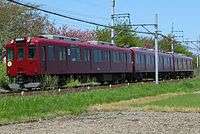Yōrō Railway Yōrō Line
| Yōrō Line | |
|---|---|
|
A Local train, 620 series | |
| Operation | |
| Operator(s) | Yōrō Railway Co., Ltd. |
| Technical | |
| Line length | 57.5 km (35.7 mi) |
| Track gauge | 1,067 mm (3 ft 6 in) |
| Minimum radius | 160 m (520 ft) |
| Electrification | 1500 V DC, overhead lines |
| Operating speed | 65 km/h (40 mph) |
| Maximum incline | 25 ‰ |
| Yōrō Railway Yōrō Line | ||||||||||||||||||||||||||||||||||||||||||||||||||||||||||||||||||||||||||||||||||||||||||||||||||||||||||||||||||||||||||||||||||||||||||||||||||||||||||||||||||||||||||||||||||||||||||||||||||||||||||||||||||||||||||||||||||||||||||||||||||||||||||||||||||||||||||||||||||||||||||||||||||||||||||||||||||||||||||||||||||||||||||||||||||||||||||
|---|---|---|---|---|---|---|---|---|---|---|---|---|---|---|---|---|---|---|---|---|---|---|---|---|---|---|---|---|---|---|---|---|---|---|---|---|---|---|---|---|---|---|---|---|---|---|---|---|---|---|---|---|---|---|---|---|---|---|---|---|---|---|---|---|---|---|---|---|---|---|---|---|---|---|---|---|---|---|---|---|---|---|---|---|---|---|---|---|---|---|---|---|---|---|---|---|---|---|---|---|---|---|---|---|---|---|---|---|---|---|---|---|---|---|---|---|---|---|---|---|---|---|---|---|---|---|---|---|---|---|---|---|---|---|---|---|---|---|---|---|---|---|---|---|---|---|---|---|---|---|---|---|---|---|---|---|---|---|---|---|---|---|---|---|---|---|---|---|---|---|---|---|---|---|---|---|---|---|---|---|---|---|---|---|---|---|---|---|---|---|---|---|---|---|---|---|---|---|---|---|---|---|---|---|---|---|---|---|---|---|---|---|---|---|---|---|---|---|---|---|---|---|---|---|---|---|---|---|---|---|---|---|---|---|---|---|---|---|---|---|---|---|---|---|---|---|---|---|---|---|---|---|---|---|---|---|---|---|---|---|---|---|---|---|---|---|---|---|---|---|---|---|---|---|---|---|---|---|---|---|---|---|---|---|---|---|---|---|---|---|---|---|---|---|---|---|---|---|---|---|---|---|---|---|---|---|---|---|---|---|---|---|---|---|---|---|---|---|---|---|---|---|---|---|---|---|---|---|---|---|---|---|---|---|---|---|---|---|---|---|---|---|---|---|---|---|
| ||||||||||||||||||||||||||||||||||||||||||||||||||||||||||||||||||||||||||||||||||||||||||||||||||||||||||||||||||||||||||||||||||||||||||||||||||||||||||||||||||||||||||||||||||||||||||||||||||||||||||||||||||||||||||||||||||||||||||||||||||||||||||||||||||||||||||||||||||||||||||||||||||||||||||||||||||||||||||||||||||||||||||||||||||||||||||
The Yōrō Line (養老線 Yōrō-sen) is a railway line of a Japanese private railway operator Yōrō Railway (養老鉄道 Yōrō Tetsudō). The line traverses the northeastern side of the Yōrō Mountains and connects Kuwana Station in Kuwana, Mie Prefecture and Ibi Station in Ibigawa, Gifu Prefecture.
The northern portion of the Ōgaki section is locally and unofficially called Ibi Line (揖斐線 Ibi-sen), as Ōgaki is a reversing station.
Kintetsu Railway, one of largest private railway companies in Japan, owns the tracks and rolling stocks of the line whereon Yōrō Railway (II), a wholly owned subsidiary of Kintetsu operates trains as of October 1, 2007.
Descriptions
- Company: Yōrō Railway (Category-2), Kintetsu Railway (Category-3)
- Length: 57.5 km (35.7 mi)
- Gauge: 1,067 mm (3 ft 6 in)
- Power: Electric 1500V DC
- No. of stations: 27 incl. both ends
- Track: single
- Maximum speed: 65 km/h (40 mph)
- Operation: All Local trains
History
Initially steam powered, the line was constructed by Yōrō Railway (I) and opened in 1913 between Yōrō - Ōgaki - Ikeno, in 1919 present line was completed with extensions of Yōrō - Kuwana and Ikeno - Ibi. In 1922 Yōrō Railway merged with Ibi River Electric (揖斐川電気 Ibigawa Denki) and the following year the line was electrified (1500V DC). In 1928 its railway was transferred to Yōrō Electric Railway (養老電気鉄道 Yōrō Denki Tetsudō). Since then the operator has changed several times, namely in 1929 the Ise Electric Railway (伊勢電気鉄道 Ise Denki Tetsudō), in 1936 Yōrō Dentetsu (養老電鉄), in 1940 Sangu Kyūkō Railway (参宮急行電鉄 Sangū Kyūkō Dentetsu), in 1941 Kansai Kyūkō Railway (関西急行鉄道 Kansai Kyūkō Tetsudō), finally in 1944 Kinki Nippon railway (近畿日本鉄道 Kinki Nippon Tetsudō) which is the present Kintetsu.
Following typhoon damage in 1959, the Kintetsu Nagoya Line was regauged to 1,435 mm (4 ft 8 1⁄2 in), the Kintetsu standard which enables through trains to Osaka, but the Yōrō Line remained 1,067 mm (3 ft 6 in) partly due to through freight trains to the then Japanese National Railways (JNR) at Ōgaki and Kuwana, because the line is shorter between these stations than JNR lines and used as the shortcut.
With accumulating deficit, Kintetsu Corporation decided to split off the operation of the Yōrō Line in 2007. Local governments along the line made an agreement of financial aid to the Yōrō Railway until 2010.
Stations
Connections
At Kuwana
- Kintetsu: Nagoya Line
- Central Japan Railway Company (JR Central): Kansai Main Line
At Ōgaki
- JR Central: Tōkaidō Main Line (the main line and the "Mino-Akasaka branch line")
- Tarumi Railway: Tarumi Line
References
This article incorporates material from the corresponding article in the Japanese Wikipedia
External links
- (Japanese) Official website
| Wikimedia Commons has media related to Yōrō Railway. |
